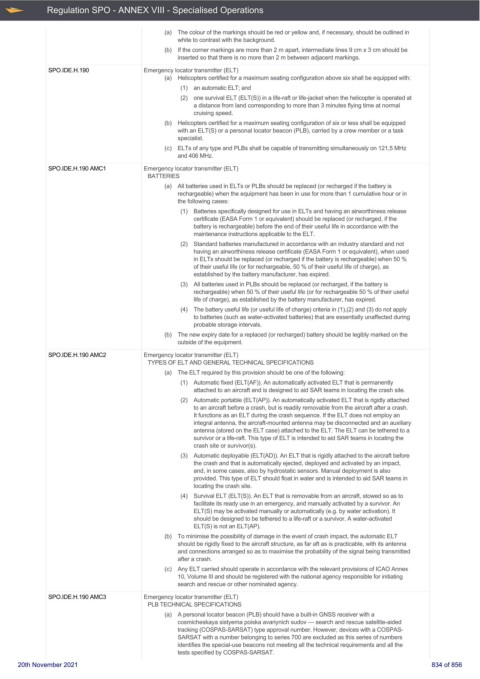Page 834 - UK Air Operations Regulations 201121
P. 834
~
~ Regulation SPO - ANNEX VIII - Specialised Operations Centrik
(a) The colour of the markings should be red or yellow and, if necessary, should be outlined in
white to contrast with the background.
(b) If the corner markings are more than 2 m apart, intermediate lines 9 cm x 3 cm should be
inserted so that there is no more than 2 m between adjacent markings.
SPO.IDE.H.190 Emergency locator transmitter (ELT)
(a) Helicopters certified for a maximum seating configuration above six shall be equipped with:
(1) an automatic ELT; and
(2) one survival ELT (ELT(S)) in a life-raft or life-jacket when the helicopter is operated at
a distance from land corresponding to more than 3 minutes flying time at normal
cruising speed.
(b) Helicopters certified for a maximum seating configuration of six or less shall be equipped
with an ELT(S) or a personal locator beacon (PLB), carried by a crew member or a task
specialist.
(c) ELTs of any type and PLBs shall be capable of transmitting simultaneously on 121,5 MHz
and 406 MHz.
SPO.IDE.H.190 AMC1 Emergency locator transmitter (ELT)
BATTERIES
(a) All batteries used in ELTs or PLBs should be replaced (or recharged if the battery is
rechargeable) when the equipment has been in use for more than 1 cumulative hour or in
the following cases:
(1) Batteries specifically designed for use in ELTs and having an airworthiness release
certificate (EASA Form 1 or equivalent) should be replaced (or recharged, if the
battery is rechargeable) before the end of their useful life in accordance with the
maintenance instructions applicable to the ELT.
(2) Standard batteries manufactured in accordance with an industry standard and not
having an airworthiness release certificate (EASA Form 1 or equivalent), when used
in ELTs should be replaced (or recharged if the battery is rechargeable) when 50 %
of their useful life (or for rechargeable, 50 % of their useful life of charge), as
established by the battery manufacturer, has expired.
(3) All batteries used in PLBs should be replaced (or recharged, if the battery is
rechargeable) when 50 % of their useful life (or for rechargeable 50 % of their useful
life of charge), as established by the battery manufacturer, has expired.
(4) The battery useful life (or useful life of charge) criteria in (1),(2) and (3) do not apply
to batteries (such as water-activated batteries) that are essentially unaffected during
probable storage intervals.
(b) The new expiry date for a replaced (or recharged) battery should be legibly marked on the
outside of the equipment.
SPO.IDE.H.190 AMC2 Emergency locator transmitter (ELT)
TYPES OF ELT AND GENERAL TECHNICAL SPECIFICATIONS
(a) The ELT required by this provision should be one of the following:
(1) Automatic fixed (ELT(AF)). An automatically activated ELT that is permanently
attached to an aircraft and is designed to aid SAR teams in locating the crash site.
(2) Automatic portable (ELT(AP)). An automatically activated ELT that is rigidly attached
to an aircraft before a crash, but is readily removable from the aircraft after a crash.
It functions as an ELT during the crash sequence. If the ELT does not employ an
integral antenna, the aircraft-mounted antenna may be disconnected and an auxiliary
antenna (stored on the ELT case) attached to the ELT. The ELT can be tethered to a
survivor or a life-raft. This type of ELT is intended to aid SAR teams in locating the
crash site or survivor(s).
(3) Automatic deployable (ELT(AD)). An ELT that is rigidly attached to the aircraft before
the crash and that is automatically ejected, deployed and activated by an impact,
and, in some cases, also by hydrostatic sensors. Manual deployment is also
provided. This type of ELT should float in water and is intended to aid SAR teams in
locating the crash site.
(4) Survival ELT (ELT(S)). An ELT that is removable from an aircraft, stowed so as to
facilitate its ready use in an emergency, and manually activated by a survivor. An
ELT(S) may be activated manually or automatically (e.g. by water activation). It
should be designed to be tethered to a life-raft or a survivor. A water-activated
ELT(S) is not an ELT(AP).
(b) To minimise the possibility of damage in the event of crash impact, the automatic ELT
should be rigidly fixed to the aircraft structure, as far aft as is practicable, with its antenna
and connections arranged so as to maximise the probability of the signal being transmitted
after a crash.
(c) Any ELT carried should operate in accordance with the relevant provisions of ICAO Annex
10, Volume III and should be registered with the national agency responsible for initiating
search and rescue or other nominated agency.
SPO.IDE.H.190 AMC3 Emergency locator transmitter (ELT)
PLB TECHNICAL SPECIFICATIONS
(a) A personal locator beacon (PLB) should have a built-in GNSS receiver with a
cosmicheskaya sistyema poiska avariynich sudov — search and rescue satellite-aided
tracking (COSPAS-SARSAT) type approval number. However, devices with a COSPAS-
SARSAT with a number belonging to series 700 are excluded as this series of numbers
identifies the special-use beacons not meeting all the technical requirements and all the
tests specified by COSPAS-SARSAT.
20th November 2021 834 of 856

